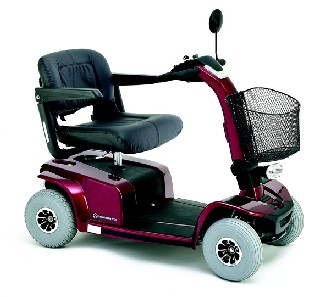More Details
FRAME
This scooter has an epoxy coated steel frame, moulded plastic cowlings, rubber protection strip at the front,side and rear of the base and a slip resistant matting on the foot platform. Rear suspension and a top speed to 9.5km/h.
TRANSPORTING
Easily accessible tie down points
The scooter can be dismantled into 7 parts for transport - seat, battery cover, batteries and battery boxes, chassis unit, and power pack. Heaviest piece when dismantled is 25kg (3-wheel)and 30kg (4-wheel).
SEAT can have two release levers. The first (on standard and adjustable seats) is located underneath the front (right hand side) of the seat base and allows the seat to swivel through 180 degrees, locking at 0, 45 and 90 degrees. The second (on adjustable seats) located at the side (right rear), allows the seat to slide forwards and backwards. The armrests pivot up and down.
STEERING COLUMN
Can be height and tilt adjusted. Features foam wraparound covered handles.
CONTROLS
The programmable controller features proportional speed control; soft touch panel buttons to select one of four speed settings, horn and lights ; battery level indictor and wraparound handles with thumb / finger controls.
FRONT WHEELS
900mm x 250mm pneumatic tyres
REAR WHEELS
100mm x 250mm pneumatic tyres
ANTI-TIPS on the rear
BATTERIES
The scooter is powered by two 32AH or the options of 40AH which are housed, along with the built in charger, under the seat. The charger point is located above the rear protection strip.
BATTERY CHARGING
is achieved by connecting the scooter from the rear charger inlet to a mains power point.
FOOTREST
is a flat platform between the steering column and battery cover
BRAKES
Electronic, regenerative and electromagnetic
FREEWHEELING
The scooter can be free wheeled by pulling out a lever located at the rear right hand corner of the base.
SUSPENSION
front/rear
ACCESSORIES
Front basket and rearview mirror standard
Factors To Consider
This item should be trialled in the users home environment to ensure maximum safety / independence. Environmental considerations include kerbs, footpaths, road / railway crossings, etc
The space allowed on public transport for carrying mobility equipment is an area of 1300mm by 800mm.
State transit will only carry scooters with an unladen weight of less than 200 kg and which can be driven onto the bus, and manoeuvred to fit wholly within the designated wheelchair space under their own power. Any such scooters carried must also comply where relevant with the rules applying to wheelchairs.
Three wheeled mobility aids of any kind are unstable in normal bus operations and will not be carried because of the safety risk.



 subscribers
subscribers 



